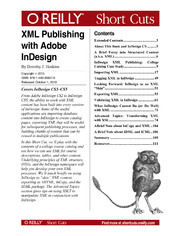XML Publishing with Adobe InDesign - Helion

ISBN: 978-14-493-9780-7
stron: 111, Format: ebook
Data wydania: 2010-09-30
Ksi─Ögarnia: Helion
Cena ksi─ů┼╝ki: 33,92 z┼é (poprzednio: 39,44 z┼é)
Oszczędzasz: 14% (-5,52 zł)
From Adobe InDesign CS2 to InDesign CS5, the ability to work with XML content has been built into every version of InDesign. Some of the useful applications are importing database content into InDesign to create catalog pages, exporting XML that will be useful for subsequent publishing processes, and building chunks of content that can be reused in multiple publications.
In this Short Cut, we’ll play with the contents of a college course catalog and see how we can use XML for course descriptions, tables, and other content. Underlying principles of XML structure, DTDs, and the InDesign namespace will help you develop your own XML processes. We’ll touch briefly on using InDesign to “skin” XML content, exporting as XHTML, InCopy, and the IDML package. The Advanced Topics section gives tips on using XSLT to manipulate XML in conjunction with InDesign.
Osoby które kupowały "XML Publishing with Adobe InDesign", wybierały także:
- Adobe InDesign CC/CC PL. Oficjalny podręcznik 77,10 zł, (23,90 zł -69%)
- Adobe InDesign CC. Skład dokumentów elektronicznych. Kurs video 99,00 zł, (44,55 zł -55%)
- Adobe InDesign CC. Kurs video. Poziom drugi. Automatyzacja pracy i zaawansowane techniki składu 79,00 zł, (35,55 zł -55%)
- Adobe InDesign PL. Oficjalny podr 129,00 zł, (64,50 zł -50%)
- Kompendium DTP. Adobe Photoshop, Illustrator, InDesign i Acrobat w praktyce. Wydanie III 199,00 zł, (99,50 zł -50%)
Spis tre┼Ťci
XML Publishing with Adobe InDesign eBook -- spis tre┼Ťci
- XML Publishing with Adobe InDesign
- About This Book and InDesign CS
- A Brief Foray into Structured Content (a.k.a. XML)
- InDesign XML Publishing: College Catalog Case Study
- Data-like Content Example: The Course Description XML
- Data exported as XML
- Modeling the structure for the import XML
- Topical Content: The Handbook XML
- Evaluating the handbook text for structure
- Modeling the structure as a set of topics
- Iteration and refinement
- Net results: vast improvements in understanding and speed
- Data-like Content Example: The Course Description XML
- Importing XML
- Doing It Adobes Way: The Placeholder Approach
- Model the XML you want
- Get some structure into InDesign
- Create placeholders for XML elements
- Creating test XML
- Importing XML into placeholders
- Adding style to the XML elements
- Mapping styles to tags
- Importing the "real" XML file
- An aside: the scary Map Styles to Tags dialog message
- Model the XML you want
- Mingling non-XML and XML content in a text flow
- Exporting XHTML when XML is in your InDesign file
- Doing It Your Way: Using the Options for Your Own Process
- Import XML using only Merge, no other import settings
- Using Append
- Linking to external XML files
- External updates on Open and using the Links palette
- Creating text flows for the imported XML
- The importance of "document order" for imported XML
- Rearranging XML elements in the structure pane
- Fixing up structure in the Story Editor
- Import XML using only Merge, no other import settings
- Understanding InDesign's XML Import Options
- Using "Clone repeating text elements"
- Importing only elements that match structure
- Avoiding overwriting text labels in the placeholder elements
- Deleting non-matching structure, text, and layout components
- Importing Images
- Inline image imports
- Doing It Adobes Way: The Placeholder Approach
- Tagging XML in InDesign
- The Case for Tagging Content: Why You Need XML
- Tagging for Import
- Tagging for Iterative XML Development
- Working without an initial DTD
- Looking Forward: InDesign as an XML "Skin"
- Exporting XML
- Marking Up (Tagging) Existing Content for XML Export
- The Special Case of InDesign Tables (Namespaced XML)
- Examining the table
- Tagging Images as XML in InDesign
- Image Options in the Export XML Dialog
- Validating XML in InDesign
- Why validate?
- How to Validate XML in InDesign
- Loading a DTD and getting the correct root element
- Authoring with a DTD
- Dealing with validation problems
- Occurrence and sequences of elements
- Validating outside of InDesign
- Duplicating structure to build XML
- Cleaning up imported XML content
- Fast and Light Credo: Develop Now, Validate Later
- Iterating the information structure and DTD
- What InDesign Cannot Do (or Do Well) with XML
- The 1:1 Import Conundrum
- Bad Characters
- Inscrutable Errors, Messages, and Crashes
- The Devilish DTD suggestions
- Exporting from the element with the included DTD will not be valid
- Don't make InDesign "think" too hard on import or export with XSL
- InDesign CS5: XML Structure option for exporting XHTML
- Advanced Topics: Transforming XML with XSL
- An Aside Regarding Scripting InDesign and XML Rules-based Publishing
- XSLT for Wrangling XML; XML Scripting for Automating XML Publishing
- XSL: Extracting Elements from a Source XML File for a New Use
- XSL: Getting the Elements to Sort Themselves
- XSL: Getting Rid of Elements You Don't Want
- Creating Wrappers for Repeating Chunks
- Making a Table from Element Structures
- Upcasting Versus Downcasting
- Upcasting from HTML to XML for InDesign Import
- Downcasting to HTML
- Generate a Link with XSLT (Not Automated)
- Adding Useful Attributes to XML
- A general formula for adding attributes
- Generating an id attribute for a div
- Use of the lang attribute for translations
- Creating an image href attribute
- Pathing to images
- A Word about Using Find/Change for XML Markup in InDesign
- A Brief Note about InCopy and XML
- A Brief Note about IDML and ICML
- Summary
- Resources
- InDesign Resources
- XML Resources
- XSLT Resources
- Acknowledgements
- About the Author





